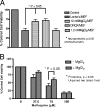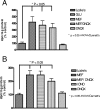Mefloquine-induced disruption of calcium homeostasis in mammalian cells is similar to that induced by ionomycin
- PMID: 17999964
- PMCID: PMC2224738
- DOI: 10.1128/AAC.00874-07
Mefloquine-induced disruption of calcium homeostasis in mammalian cells is similar to that induced by ionomycin
Abstract
In previous studies, we have shown that mefloquine disrupts calcium homeostasis in neurons by depletion of endoplasmic reticulum (ER) stores, followed by an influx of external calcium across the plasma membrane. In this study, we explore two hypotheses concerning the mechanism(s) of action of mefloquine. First, we investigated the possibility that mefloquine activates non-N-methyl-d-aspartic acid receptors and the inositol phosphate 3 (IP3) signaling cascade leading to ER calcium release. Second, we compared the disruptive effects of mefloquine on calcium homeostasis to those of ionomycin in neuronal and nonneuronal cells. Ionomycin is known to discharge the ER calcium store (through an undefined mechanism), which induces capacitative calcium entry (CCE). In radioligand binding assays, mefloquine showed no affinity for the known binding sites of several glutamate receptor subtypes. The pattern of neuroprotection induced by a panel of glutamate receptor antagonists was dissimilar to that of mefloquine. Both mefloquine and ionomycin exhibited dose-related and qualitatively similar disruptions of calcium homeostasis in both neurons and macrophages. The influx of external calcium was blocked by the inhibitors of CCE in a dose-related fashion. Both mefloquine and ionomycin upregulated the IP3 pathway in a manner that we interpret to be secondary to CCE. Collectively, these data suggest that mefloquine does not activate glutamate receptors and that it disrupts calcium homeostasis in mammalian cells in a manner similar to that of ionomycin.
Figures








Similar articles
-
The acute neurotoxicity of mefloquine may be mediated through a disruption of calcium homeostasis and ER function in vitro.Malar J. 2003 Jun 12;2:14. doi: 10.1186/1475-2875-2-14. Epub 2003 Jun 12. Malar J. 2003. PMID: 12848898 Free PMC article.
-
Transcriptional profiling of mefloquine-induced disruption of calcium homeostasis in neurons in vitro.Genomics. 2005 Nov;86(5):539-50. doi: 10.1016/j.ygeno.2005.07.004. Epub 2005 Aug 18. Genomics. 2005. PMID: 16109470
-
Mefloquine induces oxidative stress and neurodegeneration in primary rat cortical neurons.Neurotoxicology. 2010 Sep;31(5):518-23. doi: 10.1016/j.neuro.2010.05.005. Epub 2010 May 24. Neurotoxicology. 2010. PMID: 20562019
-
Excitatory amino acid-mediated cytotoxicity and calcium homeostasis in cultured neurons.J Neurochem. 1993 Apr;60(4):1202-11. doi: 10.1111/j.1471-4159.1993.tb03278.x. J Neurochem. 1993. PMID: 8455022 Review.
-
IP3R, store-operated Ca2+ entry and neuronal Ca2+ homoeostasis in Drosophila.Biochem Soc Trans. 2012 Feb;40(1):279-81. doi: 10.1042/BST20110618. Biochem Soc Trans. 2012. PMID: 22260705 Review.
Cited by
-
Identification of compounds that cause axonal dieback without cytotoxicity in dorsal root ganglia explants and intervertebral disc cells with potential to treat pain via denervation.PLoS One. 2024 May 2;19(5):e0300254. doi: 10.1371/journal.pone.0300254. eCollection 2024. PLoS One. 2024. PMID: 38696450 Free PMC article.
-
Neuronal pannexin-1 channels are not molecular routes of water influx during spreading depolarization-induced dendritic beading.J Cereb Blood Flow Metab. 2017 May;37(5):1626-1633. doi: 10.1177/0271678X16639328. Epub 2016 Jan 1. J Cereb Blood Flow Metab. 2017. PMID: 26994044 Free PMC article.
-
Mefloquine and psychotomimetics share neurotransmitter receptor and transporter interactions in vitro.Psychopharmacology (Berl). 2014 Jul;231(14):2771-83. doi: 10.1007/s00213-014-3446-0. Epub 2014 Feb 2. Psychopharmacology (Berl). 2014. PMID: 24488404 Free PMC article.
-
Pore-forming toxin-mediated ion dysregulation leads to death receptor-independent necroptosis of lung epithelial cells during bacterial pneumonia.Cell Death Differ. 2017 May;24(5):917-928. doi: 10.1038/cdd.2017.49. Epub 2017 Apr 7. Cell Death Differ. 2017. PMID: 28387756 Free PMC article.
-
Effect of M-phase kinase phosphorylations on type 1 inositol 1,4,5-trisphosphate receptor-mediated Ca2+ responses in mouse eggs.Cell Calcium. 2015 Nov;58(5):476-88. doi: 10.1016/j.ceca.2015.07.004. Epub 2015 Aug 1. Cell Calcium. 2015. PMID: 26259730 Free PMC article.
References
-
- Aarnoudse, A. L., R. H. van Schaik, J. Dieleman, M. Molokhia, M. M. van Riemsdijk, R. J. Ligthelm, D. Overbosch, I. P. van der Heiden, and B. H. Stricker. 2006. MDR1 gene polymorphisms are associated with neuropsychiatric adverse effects of mefloquine. Clin. Pharmacol. Ther. 80:367-374. - PubMed
-
- Agus, Z. S., E. Kelepouris, I. Dukes, and M. Morad. 1989. Cytosolic magnesium modulates calcium channel activity in mammalian ventricular cells. Am. J. Physiol. 256:C452-C455. - PubMed
-
- Anonymous. 1996. Guide for the care and use of laboratory animals. National Research Council, Washington, DC.
-
- Baudry, S., Y. T. Pham, B. Baune, S. Vidrequin, C. Crevoisier, F. Gimenez, and R. Farinotti. 1997. Stereoselective passage of mefloquine through the blood-brain barrier in the rat. J. Pharm. Pharmacol. 49:1086-1090. - PubMed
MeSH terms
Substances
LinkOut - more resources
Full Text Sources

